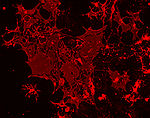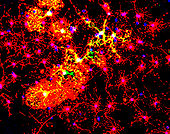Oligodendrocyte
A oligodendrocyte is a type of neuroglia (neuron support cell) that is located in the central nervous system. Their primary tasks are to form an insulating sheath on the nervous fiber’s axons, and to produce myelin. This neuroglia contains dense cytoplasm. The word Oligodendroglia is related to the fact that when looking through a microscope it looked like the cell's projections formed a the branches of a tree. The Greek root "oligo-" means few or scant, "dendron" means tree and "-cyte" meaning cell. [1]
Functions
One oligodendrocyte can myelinate up to 15 axons at one time. In order to surround the axon with the protective tissue the oligodendrocyte must spin fully around it a few times. This creates a the layered myelin sheath, the result of the oligodendrocyte's cytoplasm expelling forth until the ends of the membrane come together [2] A single oligodendrocyte can myelinate several axons (usually 10 - 15). The formation of a myelin sheath is the result of a process from an oligodendrocyte spiralling around an axon so that the cytoplasm is extruded until the opposite membranes meet, thus forming a multi-layered lipoprotein coat with a node of Ranvier at each end. An internode is the section between two nodes of Ranvier.
The oligodendrocyte is categorized as a glial cell, these specific cells contribute to the Central Nervous System by supporting and taking care of the brain cells. They cover the Central Nervous System’s nerve fiber’s axons with a insulated tissue called myelin. The myelin sheath produced by the oligodendrocyte is responsible for protecting the axons of the brain which transmit information from the brain to the other parts of the body [3]. Demyelination occurs when the the ability to transmit nerve impulses and information is stopped [2] The most accurate estimation of the size of myelin sheaths once wrapped about the brain cells is .039 inches thick [4]. The oligodendroglia is divided into perineuronal, interfascicular, and per vascular categories

[4] Interfascicular oligodendrocytes can be found in the body lined up side by side amongst the white matter nerve fibres [4]. The perineuronal oligodendrocytes are located in the Central Nervous System’s grey matter. This type of oligodendrocytes are always living near the neuron’s somata [4].
Damage Caused by Oligodendroglia
Destruction of the myelin sheaths produced by the oligodendrocytes can lead to: -Movement of the body -Speech -Eye sight -Hearing complications -Brain and body development
A condition that exhibit’s the negative effects of the body without active oligodendroglia is Periventricular Leukomalacia. The timing of this glial cell is absolutely crucial during the first stages of life. If a baby is born premature, the white matter is immature, if the precursors for the oligodendrocytes are in the process of differentiating and proliferating before the oligodendrocytes have time to coat the axons with myelin sheaths then the result will be the central nervous system’s white matter can be turned into a abnormal tissue[5].
Multiple Sclerosis is also a result of damage to the nerve fibres of the central nervous system. Oligodendrocytes are responsible for repairing the myelin sheath when part of all of it is destroyed, multiple sclerosis is a result of the sheaths not being repaired in time. This disease is the result of nerve cells being destroyed by inflammation from the immune system. The axon’s impulses of the nerve are stopped when the layer of myelin surrounding them is damaged. The reason as to why this inflammation occurs is unknown [6].
Leukodystrophy is a genetic and uncommon form of disease which destroys the sheaths surrounding the axons of the brain.[3]
Other diseases and disorders by the failing of oligodendrocytes can lead to the damage of the spinal cord,and stroke. Researchers have also discovered that the destruction of the oligodendrocyte’s sheaths may be tied to bipolar disorder as well as Schizophrenia.Oligodendroglia is easily affected by a infection known as the JC virus, this is the main cause of progressive multimodal leukoencephalopathy [4].
References
- ↑ (Oligodendrocyte) Author unknown, MedicineNet, December 13, 1998
- ↑ 2.0 2.1 Demyelinating Diseases (Anatomy) Walter R Timperley, Global Health Network, 18 Apr. 2000.
- ↑ 3.0 3.1 Leukodystrophies Unknown author, MedlinePlus, National Institutes of Health, February 16, 2011.
- ↑ 4.0 4.1 4.2 4.3 4.4 (What Are) S. Gadd,wiseGEEK, November 14, 2010. Cite error: Invalid
<ref>tag; name "oligodendrocyte" defined multiple times with different content Cite error: Invalid<ref>tag; name "oligodendrocyte" defined multiple times with different content Cite error: Invalid<ref>tag; name "oligodendrocyte" defined multiple times with different content Cite error: Invalid<ref>tag; name "oligodendrocyte" defined multiple times with different content - ↑ [1] Kinney HC, September 1998
- ↑ (Multiple sclerosis) David Zieve, August 5, 2010
| ||||||||||||||||||||




